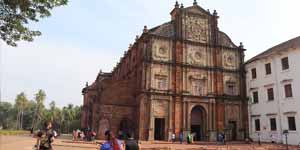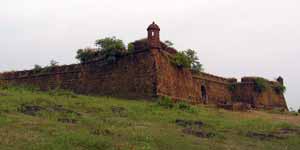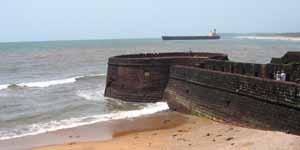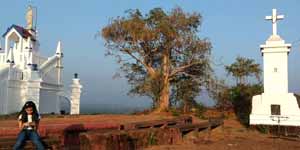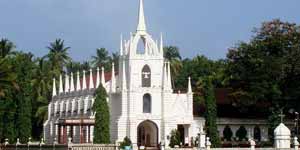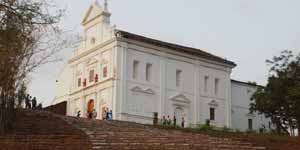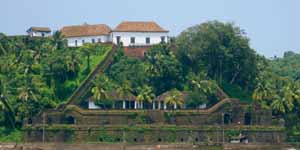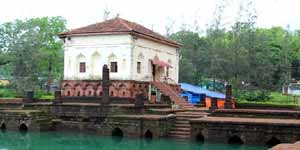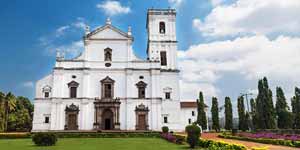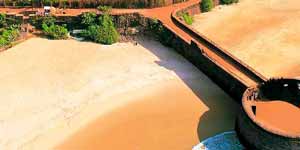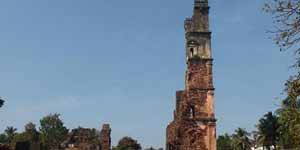
Fort Aguada
The Fort Aguada is one of the largest and impressive forts preserved as one of the best known landmarks in Goan history. Its prominence has grown from the fact that its headland on which it is built offers a wonderful site for military architects due to its shielding of the vital sea access from the heart of the Portuguese territory thereby making it an ideal site for seaward as well as landward defense.
The elimination of the Maratha threat and the acquisition of the New Conquest added more glory to its importance right upto the end of the 18th century when Goa's future borders were established. The most vital part of it was its impregnability to survive attacks by enemies through land or sea or simultaneously from both sides which often happened.
The most feared threat for the Portuguese came from the Europeans in the east, which came true when a Dutch squadron approached the Mandovi in 1604. The Reis Magos Fort, Gaspar Dias Fort and the Cabo Fort proved to be futile in keeping them at bay and though eventually warded off, the Dutch succeeded in burning quite a number of Portuguese ships. In 1606, they returned back and settled at the entrance of the river, blocking the harbour and preventing the entry or departure of all the ships.
The Portuguese naval strength was now actually not enough to face the Dutch for an open sea battle whereby they had to resort to defensive methods against the Dutch to keep them at a safe distance meanwhile work on building a fort was started on the headland which was completely finished in 1612. During the reign of the Catholic King Dom Filippe of Portugal, the construction of the fortress began with orders from the municipality levying 1 percent duty towards protection and defence of ships approaching the fort. The Fortress was finally completed in 1612 by the members of the Municipality under the administration of Viceroy Ruy Tavara.
The water link with the sea on the north side was extended with the use of the Nerul river which dissolves into creeks beyond the peninsula and the whole of the headland was utilized as well making it a thoroughly defensible island. The fort was built as per the design laid down by the Italian military architects employed by the Portuguese government in Lisbon. On the highest point of the headland, there is a citadel which is linked by a defended passage to the riverside. The entire area at sea level is surrounded by fat walls with occasionally occurring bastions along the riverside. The outer wall part has now disappeared though there are still fragments which can be seen, distinctively along the river.
Fort Aguada: History
Fort Aguada traces its origins to 1609 when its construction was started by the Portuguese who were ruling over the region. The construction continued for the next three years and was completed in 1612 under the supervision of Viceroy Ruy Tavara. The word Aguada means freshwater in Portuguese language and the fort derives its name from a freshwater spring located within it. It is recorded that crews of sailing ships used to replenish their stock of potable water from this spring.
Aguada Fort was built to guard and defend the Portuguese stronghold in Goa against the Maratha and Dutch invaders. Owing to its location at the confluence of the Arabian Sea and the Mandovi River, it became the most prized fortress for the Portuguese back in the seventeenth century.
In 1864, a four-storied lighthouse was erected within the fort’s premises. For a long time after that, the fort served as a reference point for the ships and vessels sailing in from Europe, thanks to the lighthouse. In 1976, the lighthouse was finally abandoned and it is currently closed to the public. However, there is a new lighthouse built in the fort premises, which is called the Aguada Lighthouse. Interestingly, the fort premises also houses a jail which was actively used during the administration of the 100th prime minister of Portugal, called Salazar. It is one of those few forts in India that has never been conquered by an enemy.
Fort Aguada Architecture
Aguada Fort is a splendid example of the Portuguese military style of architecture. It was constructed using laterite stone, which was found in abundance in Goa. The fort is categorized into two parts – the upper part and the lower part. The upper part was designed to serve as a fort and a huge watering station. The lower part extended a safe berth for the ships belonging to the Portuguese rulers. The fort is enveloped by walls as high as 5 meters and as wide as 1.3 meters. There are bastions that surround the fort on three sides while the fourth side has a gateway that faces the Mandovi River.
In its heydays, Aguada Fort served as one of the largest freshwater storages of Asia and had the capacity to store 2,376,000 gallons of water. The fort also features a gunpowder room, bastions, and a moat. One of the most attractive aspects of the fort’s architecture is a secret passage which was built to help the occupants escape in the case of an emergency or war.
Monuments in Goa
Monuments In Goa If your planning to come on a holiday to Goa, dont ever miss a chance to explore the monumental wonders that flavour this palm-fringed place! Tourists from all over the world cluster here to muddle up with the golden sand and beaches of Goa. Surprisingly very few people are aware of the fact that besides, being a beach state, this place is actually a treasure trove of architectural marvels. You will be amazed to see an impressive array of medieval European architecture - an exclusive interweaving of Portuguese-Gothic style with a Tuscan exterior and Corinthian interior - exhibited inside the walls of these spectacular monuments. The sheer scale and proportion of the country mansions together with the magnificence of its interiors makes them the grandest of all country mansions.
A monument is a statue, building, or other edifice created to commemorate a person, event or as an artistic object. They are frequently used to improve the appearance of a city or location. The Ancient Monuments and Archaeological Sites and Remains Act, 1958 defines an Ancient Monument
Ancient Monument means any structure, erection or monument, or any tumulus or place of interment, or any cave, rock-sculpture, inscription or monolith which is of historical, archaeological or artistic interest and which has been in existence for not less than 100 years and includes:- remains of an ancient monument, Site of an ancient monument. Such portion of land adjoining the site of an ancient monument as may be required for fencing or covering in or otherwise preserving such monument,The means of access to, and convenient inspection of, an ancient monument.
Some of the beautiful monuments of goa are:- Viceroys Arch Goa, Statue of Abbe Faria Goa, Azad Maidan Goa, Goa Medical College Goa etc.
The calm churches, rugged forts, exquisite temples and grandiose country mansions of Goa attract countless tourists from all over the world. So, feel the pleasure of visiting these numerous structures that highlights this beautiful beach land of India.


